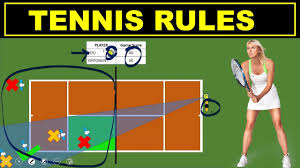Tennis Rules
SPORT
8/13/20252 min read


Tennis is a sport played either one-on-one (singles) or in teams of two (doubles) on a rectangular court divided by a net. The goal is to hit a ball with a racket over the net and into your opponent's court in a way that they cannot legally return it.
Basic Gameplay
Serving: A point begins with a serve. The server stands behind the baseline and must hit the ball diagonally into the opponent's service box.
You get two chances to make a legal serve. A "fault" is an illegal serve (e.g., if it hits the net and doesn't land in the service box, or if it lands outside the correct service box).
Two consecutive faults ("double fault") results in the loss of the point.
A "let" is a serve that hits the net but still lands in the correct service box. It's a do-over, with no penalty.
The server alternates serving sides after each point. The first point of a game is always served from the right side of the court.
Rally: After a legal serve, players hit the ball back and forth until one player fails to make a legal return. A legal return can be made after the ball bounces once, but before it bounces a second time.
Winning a Point: A player wins a point if:
The opponent's serve is a double fault.
The opponent fails to hit the ball over the net and into the correct court.
The opponent hits the ball outside the court boundaries.
The opponent's racket or body touches the net while the ball is in play.
Scoring
Tennis has a unique scoring system, progressing from points to games, and then to sets and matches.
Points:
A score of zero is called "love."
The first point is 15.
The second point is 30.
The third point is 40.
The fourth point wins the game, unless the score is tied at 40-40.
Deuce and Advantage:
When the score is tied at 40-40, it's called "deuce."
To win the game from deuce, a player must win two consecutive points.
The first point won after deuce gives that player the "advantage" (often called "Ad-In" for the server or "Ad-Out" for the receiver).
If the player with the advantage wins the next point, they win the game. If they lose the next point, the score returns to deuce.
Games: A player must win four points to win a game, and must have a two-point lead.
Sets: A set is won by the first player to win six games with a margin of at least two games (e.g., 6-4).
If a set is tied at 5-5, a player must win the next two games to win the set 7-5.
If a set reaches 6-6, a tiebreak game is usually played. In a tiebreak, points are counted as 1, 2, 3, etc., and the first player to reach seven points with a two-point lead wins the tiebreak and the set (e.g., 7-6).
Matches: Matches are typically played as the best of three or best of five sets. The first player to win the majority of the sets wins the match.
Court and Lines
A standard tennis court is 78 feet long.
For singles, the court is 27 feet wide.
For doubles, the court is 36 feet wide, including the "doubles alleys" on each side.
A ball that lands on any part of a line is considered "in."
